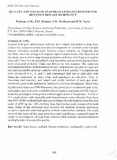Quality and yield of Snap Bean lines developed for multiple disease resistance

View/
Date
2011-09Author
Narla, R.D.
Muthomi, J. W.
Kimani, P.M.
Wahome, S.W.
Language
enMetadata
Show full item recordAbstract
Angular leaf spot, anthracnose and rust are a major constraint to snap bean
(Phaseolus vulgaris) production and development of varieties with multiple
disease resistance would assist farmers reduce reliance on fungicide and
therefore, meet the stringent European export requirements. The objective of
this study was to select snap bean populations and lines with high pod quality
and yield. Forty five advanced bush snap bean lines and six climbing snap lines
were evaluated at KARI- Thika and Mwea for two seasons. The materials
included populations with resistance to rust, anthracnose, angular leaf spot and
rust and susceptible popular varieties with good pod quality. The populations
were advanced to F4, F5 and F6 and experiment laid out as split-plot, with
fungicide treatments as main plots, and genotypes as sub-plots. Days to
flowering and maturity, pod length and width, number of pods per plant,
marketable pod yield, pod quality and seed yield were determined. There were
significant differences (P~0.05) among the genotypes in marketable pod yield,
pod quality and seed yield. HAB 428 had the highest pod yield of8528.2 kg ha'
when the genotypes were grown without application of fungicides. A total of
674 single plants with desirable pod characteristics were selected. Snap bean
line KSB 10 BR with multiple disease resistance had the highest extra fine pod
yield of 2000 kg ha'. All climbing lines had thicker pods compared to bush
lines. Some of the advanced lines selected for multiple diseases resistance
could not meet the yield and quality of bush commercial varieties. The study
showed that some of the snap bean lines and populations evaluated could be
useful in development of snap bean varieties with multiple disease resistance
and high yields of acceptable quality
Sponsorhip
National Council of Science and Technology, The Kenya Seed CompanyPublisher
Faculty of Agriculture, University of Nairobi
Description
Oral presentation at aGRO 2011 Biennial Conference
